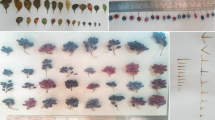Abstract
An experiment was carried out with 27 genotypes of bitter gourd (Momordica charantia L.)” at Research Farm of the Department of Vegetable Science, CCS Haryana Agricultural University, Hisar during Spring–Summer season, 2018. The genotypes were planted in three replications in Randomized Block Design. Considerable amount of variability was observed in all the genotypes for all seven morphological characters under study viz., leaf shape, leaf pubescence, fruit neck, fruit skin color, fruit shape in longitudinal section, shape of fruit at blossom end and shape of fruit at peduncle end. The genotypes viz., IC 85624 followed by HK 113, IC 85610, IC 85605 were found superior in terms of mean performance data of fruit yield and growth parameters and found promising for future improvement programme. The results of principal component analysis revealed that out of all the 16 characters, initial eight characters had more than 0.5 eigen values with more than 91% variability. Of all, PC1 (days to 50% germination) had highest eigen value (0.538) and accounted 34.60% variability, hence, selection of genotypes based on these traits can be rewarding in future breeding programmes.



Similar content being viewed by others
References
Abhijeet SK, Yadav NP, Singh VB, Mishra SK (2018) Genetic variability studies on sponge gourd [Luffa cylindrica (L.) Roem.]. Int J Agric Environ Biotechnol 11:941–945
Dubey A, Ram CN, Alam K, Shukla R, Pandey V (2022) To study the genetic variability, heritability and genetic advance for agronomic traits of Bottle gourd [Lagenaria siceraria (Mol.) Standl]. J Pharm Innov 11:1362–1366
Duhan DS, Panghal VPS, Rana MK (2017) Morphological characterization of bottle gourd [Lagenaria siceraria (Mol.) Standley] genotypes. Veg Sci 44:70–73
Jatav V, Singh DK, Singh NK, Panchbhaiya A (2022) Principal component analysis in bitter gourd (Momordica charantia L). Bangladesh J Bot 51(1):1–7
Kandasamy R, Arivazhagan E, Bharathi SS (2019) Evaluation of growth and yield characters in bottle gourd (Lagenaria siceraria (Mol.) Standl.). J Pharmacogn Phytochem 8:4653–4655
Koppad SB, Chavan ML, Patil J (2016) Character association studies in ridge gourd (Luffa acutangula L.) with reference to yield attributes. Indian J Ecol 43:176–183
Kumar D, Kumar S, Meena RK, Kumar M, Vilas R (2018) Genetic variability, heritability and genetic advance for yield and quality attributes in bitter gourd (Momordica charantia L.). Int J Pure Appl Biosci 6:499–503
Kundu S, Mandal AR, Mukherjee D, Banerjee S, Ghosh T, Mandal AK, Chattopadhyay A (2022) Breeding bitter gourd (Momordica charantia L.) for simultaneous improvement in yield, nutritional quality and downy mildew disease tolerance. Ann Plant Soil Res 24:250–258
Mladenovic E, Berenji J, Ognjanov V, Ljubojevic M, Cukanovic J (2012) Genetic variability of bottle gourd [Lagenaria siceraria (Molina) Standl.] and its morphological characterization by multivariate analysis. Arch Biol Sci 64:573–583
Rai AK, Vikram A, Pal S (2017) Genetic characterization of Tomato (Solanum lycopersicum L.) germplasm for yield and quality traits through principal component analysis. Res J Agric Sci 8(5):1171–1174
Ranjan PK, Topno SE (2022) Performance of bitter gourd (Momordica charantia L.) hybrids under Prayagraj Agro-climatic condition. J Pharm Innov 11:2181–2184
Rashid M (2004) Sabji biggan. University Press, Dhaka, p 99
Sehgal N, Kumar S (2021) Variability and traits association analyses in bacterial wilt resistant genotypes of tomato (Solanum lycopersicum L.) under mid-hill conditions of Himachal Pradesh Indian. J Exp Biol 59(09):617–625
Sidhu GK, Pathak M (2016) Genetic diversity analysis in bitter gourd (Momordica charantia L.) using morphological traits. Int J Agric Innov Res 41:59–63
Singh P, Jain PK, Tiwari A (2020) Principal component analysis approach for yield attributing traits in chilli (Capsicum annum L.) genotypes. Chem sci rev lett 9(33):87–91
Srivastava U, Mahajan RK, Gangopadhyay KK, Singh M, Dhillon BS (2011) Minimal descriptors of Agri-horticultural crops. NBPGR Pusa Campus, New Delhi, p 110012
Thakur P, Visen VK, Sharma D, Nair SK (2015) Genetic divergence studies in bottle gourd [Lagenaria Siceraria (Molina) Standl.]. Plant Arch 15:1175–1178
Uddin AFM, Jamal Tahiduls MI, Chowdhury MSN, Shiama IH, Mehraj H (2014) Evaluation of bottle gourd [Lagenaria siceraria (Mol.) Standl.] to growth and yield. Int J Biosci 5:7–11
Yadagiri J, Gupta NK, Tembhire D, Verma S (2017a) Genetic variability, heritability and morphological characterization in bitter gourd (Momordica charantia L.). Int J Pure Appl Biosci 5:1322–1327
Yetisir H, Sakar M, Serce S (2008) Collection and morphological characterization of Lagenaria siceraria germplasm from the Mediterranean region of Turkey. Genet Resour Crop Evol 55:1257–1266
Blatter E, Caius JF, Mahaskar KS (1935) Indian Medicinal Plants.2nd edn. M/s. Bishan Singh, Dehradun, pp 1130–1132
Gopalan C, Ramashastri BV, Balasubramanian SC (1982) Nutritive value of Indian foods. I.C.M.R.,Hyderabad, pp 328
Robinson RW, Decker-Walters DS (1997) Cucurbits. CAB International, pp 226
Sheoran OP (2010). Online statistical analysis (OPSTAT). A software developed by Chaudhary Charan Singh Haryana Agricultural University, Hisar. http://www.hau.ernet.in/opstat.html.
Sreejayan, Rao MNA (1991) Oxygen free radical scavenging activity of Momordica charantia fruits. Fitoterpeda 62: 344–346
Acknowledgements
We highly acknowledge the research material supports from the ICAR-Indian Institute of Vegetable Research (IIVR), Varanasi for providing us the potential germplasm for conducting this research.
Author information
Authors and Affiliations
Corresponding author
Ethics declarations
Conflict of interest
On behalf of all authors, the corresponding author states that there is no conflict of interest.
Additional information
Publisher's Note
Springer Nature remains neutral with regard to jurisdictional claims in published maps and institutional affiliations.
Rights and permissions
Springer Nature or its licensor (e.g. a society or other partner) holds exclusive rights to this article under a publishing agreement with the author(s) or other rightsholder(s); author self-archiving of the accepted manuscript version of this article is solely governed by the terms of such publishing agreement and applicable law.
About this article
Cite this article
Mehta, T., Duhan, D.S., Phogat, S. et al. Morphological characterisation and principal component analysis studies in bitter gourd (Momordica charantia L.) genotypes. Vegetos (2024). https://doi.org/10.1007/s42535-024-00869-5
Received:
Revised:
Accepted:
Published:
DOI: https://doi.org/10.1007/s42535-024-00869-5




